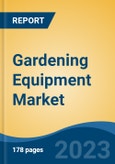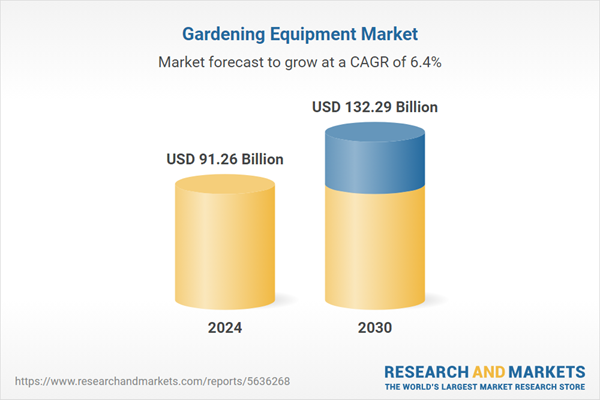Free Webex Call
Global Gardening Equipment Market was valued at USD 91.26 Billion in 2024 and is expected to reach USD 132.29 Billion by 2030 with a CAGR of 6.38% during the forecast period. Gardening equipment encompasses a wide range of tools utilized in garden maintenance. These tools include instruments specifically designed for gardens, as well as those utilized in agriculture and horticulture. Both home gardeners and business landscapers rely on lawnmowers, hand tools, power tools, trimmers, edgers, and other lawn and garden equipment. Speak directly to the analyst to clarify any post sales queries you may have.
10% Free customizationThis report comes with 10% free customization, enabling you to add data that meets your specific business needs.
The industry's growth is driven by the increasing demand for technologically advanced and automated gardening equipment for both residential and commercial purposes. The rising usage of automated weed management systems in commercial settings such as public parks, golf courses, and sports fields, as well as the expanding need for automated water sprinklers, has significantly contributed to the demand for water management systems and gardening equipment. Moreover, current trends such as organic gardening, small-space gardening, and urban farming are expected to further fuel the expansion of the Gardening Equipment Market.
Key Market Drivers
Growing Popularity of Vertical Gardening
The trend of vertical gardening is gaining momentum globally, and this is expected to significantly increase the demand for gardening equipment. Vertical gardening, a method of growing plants up a wall or out of a wall, is seen as a novel solution to the lack of space in urban areas. This type of gardening not only maximizes the use of space but also creates an aesthetic appeal. As a result, gardening tools and equipment that cater specifically to the needs of vertical gardening are in high demand. These include specially designed planters, trellises, frames, stands, and watering systems.Moreover, vertical gardens require regular maintenance, which directly boosts the need for other gardening tools like pruners, garden shears, and hoes. The trend is further driven by the growing interest in organic food production in urban settings. As more people choose to grow their own fruits, vegetables, and herbs in vertical gardens, the demand for organic gardening products, such as organic pesticides and compost, is also increasing. Therefore, the growing popularity of vertical gardening is not only promoting green living but also providing a significant boost to the global gardening equipment market.
Key Market Challenges
Heavy Maintenance Costs
One of the significant challenges facing the gardening equipment market is the high maintenance costs associated with power tools. While power tools provide convenience and efficiency in completing gardening tasks, they also require regular maintenance to ensure optimal performance and longevity. This can include tasks such as cleaning, lubrication, and periodic replacement of worn-out parts. The heavy maintenance costs can pose a barrier to market development, as some consumers may hesitate to invest in power tools that require ongoing maintenance and upkeep. Instead, they may opt to stick with traditional manual tools that have lower maintenance requirements.This preference for manual tools can hinder the adoption of power tools, impacting the growth potential of the gardening equipment market. Furthermore, maintenance costs can also impact the profitability of manufacturers and distributors in the industry. They may need to allocate significant resources to address repair and replacement needs, which can strain their financial resources. Additionally, the time and effort spent on maintenance activities can divert the focus of manufacturers and distributors from other areas such as production and innovation.
To address this challenge, manufacturers are proactively investing in research and development to create power tools with improved durability and reliability. By enhancing the quality of materials used and the design of the tools, they aim to reduce the frequency of repairs and the need for extensive maintenance. These efforts can help alleviate the financial burden on both consumers and manufacturers, making power tools a more attractive option in the gardening equipment market. Moreover, manufacturers are also offering extended warranty and repair services to provide customers with peace of mind and further reduce the financial implications of maintenance costs. These additional services not only enhance customer satisfaction but also instill confidence in the longevity and performance of the power tools they purchase.
Key Market Trends
Growing Interest in Hydroponic Gardening
Hydroponic gardening techniques are gaining popularity in industrial farming due to their numerous advantages. When compared to conventional soil-grown crop cultivation, hydroponics has shown the potential to increase crop output by 3 to 10 times within the same amount of space. This efficiency is achieved by providing plants with optimal nutrient levels through a precisely regulated hydroponic system that controls pH and fertilizer levels. Moreover, hydroponic systems offer the benefit of water conservation. Any excess water not utilized by the plants is recycled within these enclosed systems, reducing water wastage. This sustainable approach to farming aligns with the growing need for environmentally friendly agricultural practices.By cultivating plants indoors, farmers can further enhance their control over the growing conditions. They can manipulate temperature and illumination patterns to optimize plant growth and increase overall output. Additionally, hydroponic systems allow for innovative design possibilities, such as maximizing vertical real estate and boosting crop density. This vertical farming approach not only maximizes space utilization but also enables cultivation in locations with unfavorable soil conditions, expanding the possibilities for agriculture in urban areas. As a result of these benefits, the market for hydroponic gardening equipment is experiencing a significant boost, as more and more farmers embrace this technology for industrial-scale cultivation.
Key Market Players
- Briggs & Stratton, LLC
- Deere & Company
- Excel Industries, Inc.
- Falcon Garden Tools Pvt. Ltd.
- Fiskars Brands, Inc.
- Honda Motor Co. Ltd.
- Husqvarna Group
- Kubota Corporation
- MTD Products, Inc.
- Robert Bosch GmbH
Report Scope:
In this report, the Global Gardening Equipment Market has been segmented into the following categories, in addition to the industry trends which have also been detailed below:Gardening Equipment Market, By Product Type:
- Hand Tools
- Lawnmowers
- Trimmers & Edgers
- Water Management Equipment
- Others
Gardening Equipment Market, By Distribution Channel:
- Direct Sales
- Online
Gardening Equipment Market, By End User:
- Residential
- Commercial
- Industrial
Gardening Equipment Market, By Region:
- North America
- United States
- Canada
- Mexico
- Europe
- France
- United Kingdom
- Italy
- Germany
- Spain
- Asia-Pacific
- China
- India
- Japan
- Australia
- South Korea
- South America
- Brazil
- Argentina
- Colombia
- Middle East & Africa
- South Africa
- Saudi Arabia
- UAE
Competitive Landscape
Company Profiles: Detailed analysis of the major companies present in the Global Gardening Equipment Market.Available Customizations:
With the given market data, the publisher offers customizations according to a company's specific needs. The following customization options are available for the report.Company Information
- Detailed analysis and profiling of additional market players (up to five).
This product will be delivered within 1-3 business days.
Table of Contents
1. Product Overview
2. Research Methodology
3. Executive Summary
5. Global Gardening Equipment Market Outlook
6. North America Gardening Equipment Market Outlook
7. Europe Gardening Equipment Market Outlook
8. Asia-Pacific Gardening Equipment Market Outlook
9. South America Gardening Equipment Market Outlook
10. Middle East and Africa Gardening Equipment Market Outlook
11. Market Dynamics
12. Market Trends & Developments
14. Porter’s Five Forces Analysis
15. Competitive Landscape
Companies Mentioned
- Briggs & Stratton, LLC
- Deere & Company
- Excel Industries, Inc.
- Falcon Garden Tools Pvt. Ltd.
- Fiskars Brands, Inc.
- Honda Motor Co. Ltd.
- Husqvarna Group
- Kubota Corporation
- MTD Products, Inc.
- Robert Bosch GmbH
Table Information
| Report Attribute | Details |
|---|---|
| No. of Pages | 185 |
| Published | March 2025 |
| Forecast Period | 2024 - 2030 |
| Estimated Market Value ( USD | $ 91.26 Billion |
| Forecasted Market Value ( USD | $ 132.29 Billion |
| Compound Annual Growth Rate | 6.3% |
| Regions Covered | Global |
| No. of Companies Mentioned | 10 |









